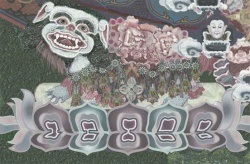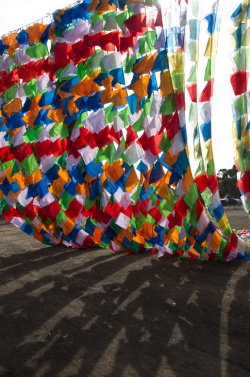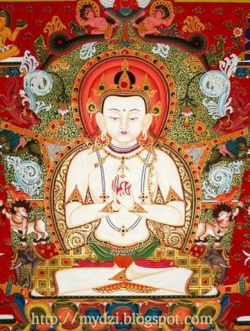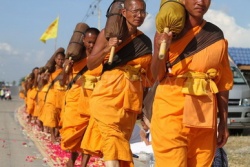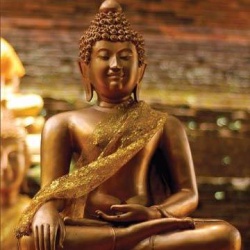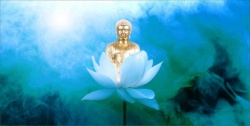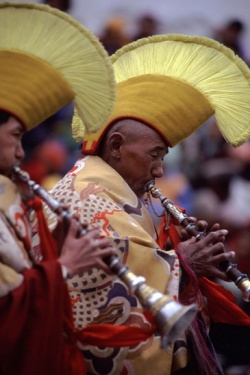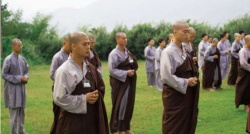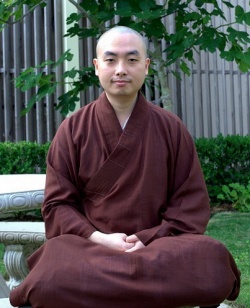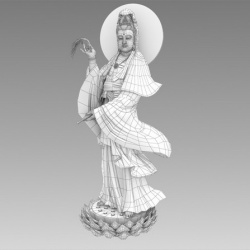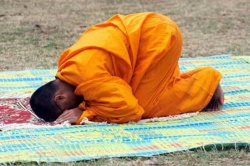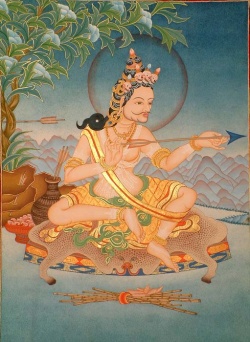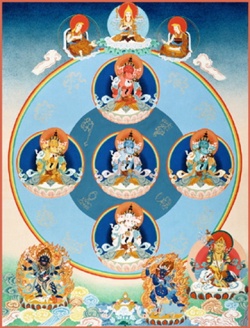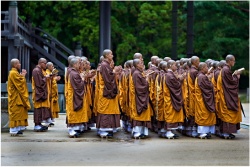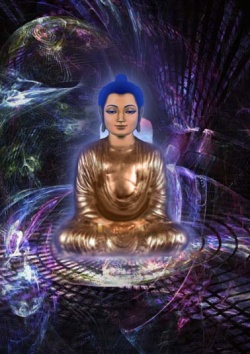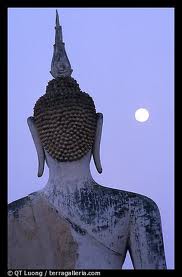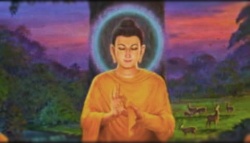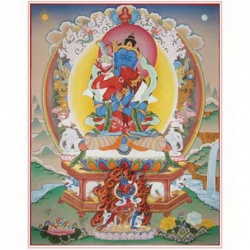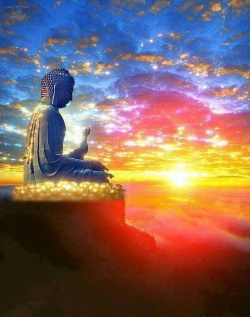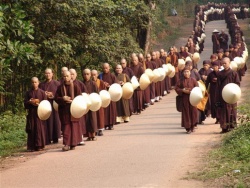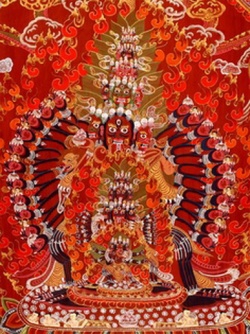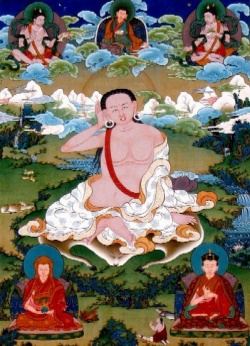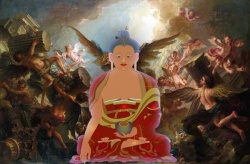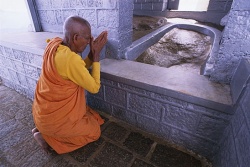Discipline and Conventions of Theravada Buddhist Renunciate Communities
A Guide for the Western Sangha
NOTE 1: This guide refers to the code of discipline of both monks (bhikkhus) and nuns (siladharas) of the Theravada school of Buddhism. Where there are differences in the rules between monks and nuns, this will be pointed out.
In the text, the term "samana" is used for both monks and nuns.
NOTE 2: This guide refers to the style of training as applied in the branch monasteries of the Thai Theravada Forest Tradition in the UK, Switzerland, Italy, Australia, New Zealand and the U.S.A.
While most Theravada monastics would not object to these standards, there may be minor differences in interpretation and application of rules in some cases.
INTRODUCTION
This guide is aimed at providing an introduction to some aspects of monastic discipline for those lay people who are interested in understanding something of the background to the rules and conventions which structure the way of life of the monks and nuns of this tradition.
It is hoped that these notes will be helpful in furthering the relationship of support between members of the Sangha and lay practitioners.
Generally, in the Indian spiritual tradition, there is difference made between those whose lifestyle is that of a householder and those who have ‘gone forth’ from the home life to follow a path of renunciation.
For the Buddhist renunciate, this spiritual life is guided by the principles of Dhamma-Vinaya.
The Buddhist monastic discipline, called Vinaya, is a refined training of body, speech and mind.
This discipline is not an end in itself, but a tool which, when applied in conjunction with the spiritual teachings (Dhamma), can help foster maturity and spiritual development.
Apart from the direct training that the Vinaya affords, it also serves to establish a supportive relationship between lay people and renunciates, which is an essential aspect of the Theravada tradition.
Within the context of this relationship Buddhist monastics give up many ordinary freedoms and undertake the discipline and conventions of Vinaya in order to focus on the cultivation of the heart.
They are able to live as mendicants because lay people respect their training and are prepared to help to support them.
This gives rise to a sense of mutual respect and co-operation in which both lay person and samana are called upon to practice their particular lifestyles and responsibilities with sensitivity and sincerity.
Many of the Vinaya rules were created specifically to avoid offending lay people or giving cause for misunderstanding or suspicion.
As naturally no samana wishes to offend by being fussy and difficult to look after, and no lay Buddhist wishes to accidentally cause samanas to transgress their discipline, this pamphlet attempts to clarify the major aspects of the Vinaya as it relates to lay people.
There are some generally accepted activities in which it would be seen as inappropriate for members of the Theravada Buddhist renunciate community to involve themselves, although these may be quite usual activities for both Buddhist monastics of other traditions and also for householders.
These include driving cars, growing their own food and officiating at marriage ceremonies.
If there is any doubt about what is appropriate, it is always possible to ask for clarification.
While samanas benefit from the companionship of dedicated lay practitioners and from being relieved from the necessity to support themselves materially, lay people benefit from the presence of committed renunciates, their teaching and their friendship.
The relationship has a ritual aspect, laid out in the conventions of Vinaya, and when approached with wisdom and compassion, this becomes the space in which a greater awareness can arise.
PROVIDING THE MEANS OF SUPPORT
The Vinaya as laid down by the Buddha defines, in its many practical rules, the status of a monastic as being one of mendicancy.
Having no personal means of support is a very practical means of understanding the instinct to seek security; furthermore, the need to seek alms gives the monastic a source of contemplation on what fundamental things are actually necessary -- namely, the four requisites.
These four requisites -- food, clothing, shelter and medicines -- are what lay people can offer as a practical instance of expressing generosity, appreciation or their faith in belonging to the Buddhist Community.
Members of the Sangha respond in various ways by helping spread goodwill and by making available the teachings of the Buddha to those who wish to hear.
THE FOUR REQUISITES
(i) Food
In Buddhist countries, where samanas make a daily alms-round through the streets, people make their intentions clear by standing by the side of the road with bowls of food, or even verbally invite the samanas to come and receive alms.
In the West where the principles of mendicancy are not so well cultivated, there is less emphasis on the daily almsround.
Instead supporters often bring food to the monasteries which can be offered for the meal that day or it can be stored in the larder.
This stored food can then be prepared by lay guests or anagarikas (postulants) and offered as the meal for the day at a later date.
Lay donors often offer food for a special occasion, e.g. on a memorial day for a deceased relative, or on a birthday.
Samanas should not directly request food unless they are sick.
This principle should be borne in mind when offering food -- rather than asking about particular preferences, it is better simply to invite the samanas to receive the food you wish to offer.
Considering that the meal will be the main meal of the day, offer what seems the right amount, recognizing that the samanas will take what they need and leave the rest.
One way to offer is to bring bowls of food to the samanas and let them choose what they need from each bowl; or the food may be set on a table, and each dish offered so that the samanas can then help themselves.
Members of the Sangha generally prefer to eat in silence.
Without getting too technical, in Vinaya food refers to anything that is eatable or drinkable, except plain water and those items specially allowed as medicine (see heading (iv) below).
The Buddha allowed his samana disciples to collect, receive and consume food between dawn and noon (which is 1:00 p.m. in Summer Time).
They are allowed neither to consume food outside of this time nor to store food overnight.
Although samanas live on whatever is offered, many would encourage vegetarianism on ethical grounds. It is not permitted for bhikkhus to cook food.
It is worth noting that, in the understanding of the Vinaya within the Forest Tradition, milk is considered to be a food, as are malted drinks such as Ovaltine and Horlicks, so these would only be allowed if offered and consumed between dawn and midday.
In considering the relationship between monastics and laity, there are certain specific rules concerning food and medicine, which are slightly different for bhikkhus and for siladharas.
Offering of Food and Medicines
A bhikkhu may only consume eatables and drinkables (including medicines) except pure water, formally offered into his hands or placed on or into something in direct contact with his hands.
In order to avoid physical contact with a woman, Thai tradition prefers that he set down a cloth to receive things offered by her.
In the monasteries, a refinement of the guideline on offering is practiced.
This means that, once offered, neither food nor medicine should be handled again by a lay person, as this implies that the lay person has taken responsibility for the food away from the samanas who therefore should not consider it to be theirs.
The rule for siladharas is slightly different, in that food or medicine should be offered ‘by body, speech or arrangement’.
Where possible it should be offered directly, e.g. women may simply hand food to a nun.
Men should not offer food directly into the hands of a nun but may simply place it down directly in front of her.
Alternatively a verbal invitation may be made: ("This is for you, Sister."; "I’ll put this on the table for you, Sister; please help yourself.")
In the Vinaya, the formal manner of offering food and medicines is fulfilled correctly when the lay person approaches within forearm’s distance of the samana, makes a gesture of offering and offers something that can be conveniently carried.
All this serves to make the act of offering a mindful and reflective one, irrespective of what one is giving.
As with all of the conventions dealt with in this booklet, it is always possible to request guidance and clarification from samanas about how to proceed with anything concerning food and offering whenever there is any doubt.
[Footnote -- One extra small refinement of the food offering etiquette usually observed in the monasteries is worth mentioning:
Making Fruit Allowable
In accordance with the discipline a bhikkhu must take care when offered fruit or vegetables containing fertile seeds.
It is best, if possible, for the seeds to be removed before offering. Another way is for the lay person to ‘make the fruit allowable’ by slightly damaging it with a knife.
So when offering these foods, this is done by piercing the fruit and saying at the same time ‘kappiyam bhante’, (meaning "I am making this allowable, sir.").
This rule does not apply to siladharas.]
(ii) Clothing
The discipline makes a standard allowance of three basic robes for bhikkhus and four for siladharas.
In the forest monasteries, samanas generally make these robes themselves from cloth that is given.
Sometimes cloth of the appropriate color is offered (please don’t hesitate to ask for a color sample) and cloth and garments of plain white cotton are also useful -- which can be dyed to the correct color -- dull ocher for bhikkhus and dark brown for siladharas.
For the thick outer robe, a woolen cloth is sometimes used, although the tradition for bhikkhus is to make this robe from two layers of thin cloth.
In a cold climate, this basic robe allowance is supplemented with other garments: sweaters, T-shirts, socks, etc., and these, of an appropriate brown color, can also be offered.
The traditional robes plus other items all need to be of the appropriate color, and not of a luxurious or opulent standard.
(iii) Shelter
Solitary, quiet and simple would be a fair description of ideal lodging for a samana.
From the scriptures it seems that the general standard of lodging was to neither cause discomfort, nor to impair health, yet not to be indulgently luxurious.
Modest furnishings of a simple and utilitarian nature were also allowed, there being a precept against using ‘high, luxurious beds and chairs’ -- i.e. items that are opulent by current standards.
So a simple bed is an allowable thing to use, and for the benefit of the back, many monastics prefer a firm surface.
However, those hosting visiting monks and nuns can rest assured that almost certainly whatever is offered would be acceptable and in keeping with the training of samanas to be easy to look after.
The Vinaya precepts do not allow bhikkhus to sleep for more than 3 nights in the same room as an unordained person, and neither bhikkhus nor siladharas should lie down in the same room with a person of the opposite sex unless in exceptional circumstances, e.g. when ill.
So, in providing a temporary lodging for the night, a lay person need not go to a lot of trouble to provide anything special -- a simple spare room is adequate -- but there should be suitably private sleeping and bathing arrangements.
(iv) Medicines and Tonics
In the Vinaya, medicines can be considered as those things consumed by eating or drinking which are not normally considered as food and:
which are specifically for illness, e.g. pharmaceuticals, homeopathic remedies, vitamin supplements etc.;
which have a tonic or reviving quality (such as tea or sugar);
which have a nutritional value in times of debilitation, hunger or fatigue (certain specified items such as fruit juice.)
In contrast to food, monastics may store these medicines overnight.
For bhikkhus, there are different limitations regarding the amount of time that such ‘medicines’ can be stored:
‘One-day’ allowance: Filtered fruit Juice (i.e. free of pulp) of any fruit.
These juices are allowed to be received and drunk any time between one dawn and the dawn of the next day -- this time-limit prevents the chance of fermentation.
‘Seven-day’ allowance: Ghee, animal or vegetable oil, honey and any kind of sugar (including molasses) can be kept and consumed any time up to the dawn of the eighth day after which they were received.
In modern times, certain other tonics are considered allowable. Donors should not hesitate to ask for clarification.
‘Life-time’ allowance: Pharmaceutical medicines, vitamins; plant roots such as ginger, ginseng; herbal decoctions, such as chamomile; beverages such as tea, coffee and cocoa.
For siladharas, all medicines are considered lifetime allowances.
Medicines which are not consumed orally, e.g. creams, massage oils, ear or eye drops, etc. may also be useful.
These do not need to be formally offered into the hands in the way food or consumable medicines do.
Other Requisites
The Buddha also allowed monastics to make use of other small requisites, such as needles, a razor, etc.
In modern times, such things might include a pen, a clock, a torch, etc.
All of these were to be plain and simple, costly or luxurious items being expressly forbidden.
Requisites may be communally owned by the monastic community, especially larger items, e.g. furniture, electronic equipment, etc.
EXTENDING AN INVITATION (PAVARANA)
The principles of mendicancy forbid samanas from asking for anything, unless they are ill, without having received prior invitation.
(Two exceptions: samanas may always ask for pure water and may make other requests from family members.)
So, as noted above, if there is the intention to give food or medicines, rather than wait for a samana to make a request, this can be made clear by saying, for example,
"May I offer you some of this food?"; "May I offer you some tea?"
One can also make invitation, ‘pavarana’, to cover any circumstances that you might not be aware of -- a health problem, need for a toothbrush, etc. -- by saying, e.g. "If you are in need of any medicine or requisites, please let me know."
To avoid misunderstanding it is better to be quite specific, such as -- "If you need any more food...," "If you need anything while you are staying here…," "If you ever need a new pair of sandals…"
Unless specified, an invitation is generally considered as lasting for up to 4 months, after which time it lapses unless renewed.
Specifying the time limit, or giving some indication of the scope of the offering prevents misunderstanding -- so that, for instance, when you are intending to offer some fruit juice, the monastic doesn’t get the impression that you want to buy a washing machine for the monastery!
INAPPROPRIATE ITEMS
(a) Luxurious Belongings
In general, it is inappropriate for a samana to accept any luxurious items.
This is because they may stimulate attachment in the samana and may excite envy in others, possibly even the intention to steal.
It also seems inappropriate for an alms mendicant, living on charity as a source of inspiration to others, to have opulent belongings.
(b) Money
The Vinaya specifies a prohibition for monks to receive money (‘gold and silver’), to instruct others to receive it or to consent to money being kept on one’s behalf.
Thus the use of and control over personal funds, whether these are in the form of coins, bank notes or credit cards, is forbidden to samanas.
Financial donations made to the Sangha are looked after by trusted lay supporters:
In practical terms, monasteries are administered financially by lay stewards, who then make open invitation for the Sangha to ask for what they need, under the direction of the senior incumbent of each monastery.
The stewards are the Trustees (or other lay people acting on their behalf) of the charitable Trusts which oversee the financial affairs of each of the monasteries. (For a list of the stewards of the monasteries, please see appendix).
Generally, individual Sangha members have to consult with a senior member of the community before they may take up the stewards’ offer, for example, to pay for dental treatment, or to obtain footwear or necessary medicines.
This is to ensure that the donations that are given to support the Sangha are used responsibly and according to the intention of the donors.
The following is an outline of the suitable way to make offerings of financial support to samanas:
If lay people wish to give something to a particular samana, but are uncertain what that individual might need, they should approach the samana in order to make invitation (pavarana).
Financial donations should not be made directly to an individual samana, but placed in a donation box, given to one of the anagarikas (dressed in white) or to one the lay stewards of the monastery, making it clear if such a offering is intended for a particular item or for the needs of a certain samana.
If inviting a member of the Sangha to visit, for example, for a teaching engagement, money to cover travelling expenses can be given to an accompanying anagarika or accompanying lay person, who can then buy tickets, drinks for a journey or anything else that the samana may need at that time.
It is quite a good training for a lay person to actually consider what items are necessary, and offer those rather than money.
RELATIONSHIPS
(Bhikkhus with women, siladharas with men)
The rules around relationships between samanas and members of the opposite sex can often lead to misunderstanding and so it is worth detailing some of the conventions that govern this.
Samanas lead lives of total celibacy, in which any kind of intentional erotic behavior is forbidden.
This includes even suggestive speech or physical contact with lustful intent -- which are very serious offences against the discipline for both bhikkhus and siladharas.
As one’s intent may not be always obvious (even to oneself) and one’s words not always guarded, it is a general principle for bhikkhus and siladharas to refrain completely from any physical contact with members of the opposite sex.
Bhikkhus should have another male present who can understand what is being said when talking with a woman, and similarly siladharas should have another woman present when speaking to a man.
Much of this standard of behavior was laid down in the Buddha’s time to prevent scandalous gossip or misunderstanding occurring.
In the stories that explain the origination of a rule, there are examples of bhikkhus being accused of being a woman’s lover, of a woman misunderstanding a bhikkhu’s reason for being with her, and even of a bhikkhu being thrashed by a jealous husband!
So to prevent such misunderstandings, however groundless, a siladhara should be with another woman whenever in the presence of a man, and a monk has to be accompanied by a man whenever in the presence of a woman -- for instance, on a journey or sitting in a secluded place (one would not call a meditation hall or a bus station a secluded place).
Generally, samanas would also refrain from carrying on correspondence with members of the opposite sex, other than for matters pertaining to the monastery, arrangements, providing basic information, etc.
TEACHING DHAMMA
The samana as Dhamma teacher must find the appropriate occasion to give the profound and insightful teachings of the Buddha to those who wish to hear it.
There are numerous definitions of what is appropriate -- where a samana is not annoying people by teaching without invitation, nor in the context where the teachings cannot be reflected upon adequately.
This is a significant point, as the Buddha’s teachings are meant to be a vehicle that one should first contemplate and then apply.
The value of Dhamma is greatly reduced if it is just received as chitchat, or speculative talk.
Accordingly for a Dhamma talk, it is good to set up a room where the teachings can be listened to with respect being shown to the speaker.
In terms of etiquette this means affording the speaker a seat and a role that is appropriate for the occasion.
It may be an informal dialogue where one should arrange the seating to help facilitate conversation; or it may be a situation where the teacher will be at the front, addressing the group.
Whatever the occasion, it is always good to consult with the speaker on how best to encourage participation, when to ask questions, etc.
Also, when inviting samanas, for instance, for the meal or a teaching engagement, it is usual for the person making the invitation to also make the travel arrangements.
MINOR MATTERS OF ETIQUETTE
Vinaya also extends into the realm of convention and custom.
These observances are not ‘rules’ but can be seen as skilful means of manifesting beautiful behavior.
In monasteries, there is some emphasis on such matters as a means of establishing harmony, order and pleasant relationships within a community.
Lay people may be interested in applying such conventions for their own training in sensitivity, but it is important for visitors to note that these are not to be considered as an imposed or obligatory standard. Such practices should only be entered into reflectively, when the individual is ready to do so.
Addressing Members of the Renunciate Community
In the Western monasteries of the Thai Theravada Forest Tradition, there are different titles used in addressing monastics:
The title ‘Venerable’ may be prefixed before a bhikkhu’s Pali name, e.g. Venerable Jayamangalo.
The Thai form ‘Tan’ may also be used for monks, e.g. Tan Parisuddho. ‘Sister’ is the respectful title used for nuns, e.g. Sister Sujata.
Both bhikkhus and siladharas who have been in the community for more than ten years are referred to as "Ajahn" (a Thai word, from the Pali acariya, which means "teacher").
Sometimes one might hear a senior bhikkhu referred to as "Tan Ajahn."
Both titles may be prefixed to the Pali name of the samana or used on its own, e.g. "Excuse me, Ajahn...," "Ajahn Sujata is coming.", "Is Tan Ajahn Parisuddho here?" etc.
All bhikkhus may be addressed with the word ‘Bhante’, and all siladharas with the respectful form ‘Sister’.
The Thai way of addressing someone who is considered a very venerable elder is ‘Luang Por,’ which means ‘Venerable Father,’ e.g. Tan Ajahn Chah is often referred to as Luang Por Chah.
Gestures of Respect
There is the custom of bowing to a shrine or teacher.
This is done when first entering their presence or when taking leave. Done gracefully at the appropriate time, this becomes a beautiful gesture that honors the person who does it.
Another common gesture of respect is to place the hands together in front of the chest, the fingers pointing upwards.
The gesture of then raising the joined hands to the slightly lowered forehead is called ‘anjali’.
This is a pleasant means of greeting, bidding farewell, saluting the end of a Dhamma talk, or concluding an offering.
Body language is something that is well-understood in Asian countries.
Some of these customs are maintained as a training in bringing attention into the body and for the benefit of bringing into awareness the importance of physical gestures of respect.
While listening to a Dhamma talk, an upright posture shows the listener’s attention is with the speaker.
Custom holds that it is disrespectful to point one’s feet at a shrine or a Buddha image, or to lie down in a shrine room (unless a sleeping place for the night is offered there).
It is considered respectful to duck slightly if having to walk between people who are speaking.
Similarly one would not stand looming over samanas to talk to them or to offer them something but rather, where possible (age and flexible joints permitting) to approach them on the level at which they are sitting.
Appropriate Dress
When visiting or staying as a guest at monasteries, it is suitable for both men and women always to be modestly dressed.
Loose, comfortable clothing is recommended. T-shirts, long sleeved tops, long trousers and suitably long skirts are all appropriate clothing for wearing in the monastery.
Even in warm weather, shorts are not suitable.
Shoes should be taken off when entering most of the monastery buildings where people sit on the floor: shrine rooms, meditation halls, meeting rooms, retreat facilities, etc.
CONCLUSION
These conventions have evolved as an aid to liberation. Sincere effort is required both to undertake the discipline oneself, and to support others in that undertaking, as well as to learn how to make it effective in leading to the goal.
In bringing us into relationship based on our aspiration to cultivate the spiritual path, it is this sincere effort which renunciates and householders alike can respect and honor.
This short guide has sought to introduce some of the main aspects of the discipline, in order to ease the way for those who are interested in entering into this relationship, and exploring how this influences our mutual well-being.
This is not an exhaustive account of the Vinaya, and so individuals are whole-heartedly encouraged to ask for more information if there is anything that is not clear.
APPENDIX
Stewards
Each monastery is supported by a Charitable Trust.
If lay people want to make financial contributions to any of these monasteries, donations should be directed to the appropriate Trust body, as outlined below:
Abhayagiri Buddhist Monastery
The Sanghapala Foundation - U.S.A
Amaravati Buddhist Monastery
The English Sangha Trust - U.K.
Aruna Ratanagiri: Harnham Buddhist Monastery
The Magga Bhavaka Trust - U.K.
Bodhinyana Buddhist Monastery
Buddhist Society of Western Australia - Australia
Bodhinyanarama Buddhist Monastery
Wellington Theravada Buddhist Association - New Zealand
Cittaviveka: Chithurst Buddhist Monastery
The English Sangha Trust - U.K.
Dhammaloka Buddhist Centre
Buddhist Society of Western Australia - Australia
Dhammapala Buddhist Monastery
Dhammapala Verein – Switzerland
Dhammasara Nuns' Monastery
Buddhist Society of Western Australia - Australia
Hartridge Buddhist Monastery
The Devon Vihara Trust - U.K.
Santacittarama Buddhist Monastery
Associazione Santacittarama - Italy
Sponsored for Free Distribution by contributions from:
English Sangha Trust, Magga Bhavaka Trust, Devon Vihara Trust, Dhammapala Verein, Sanghapala Foundation.
Source
www.budsas.org [[Category:]]
